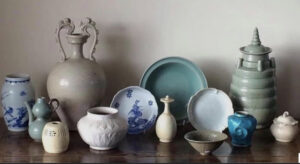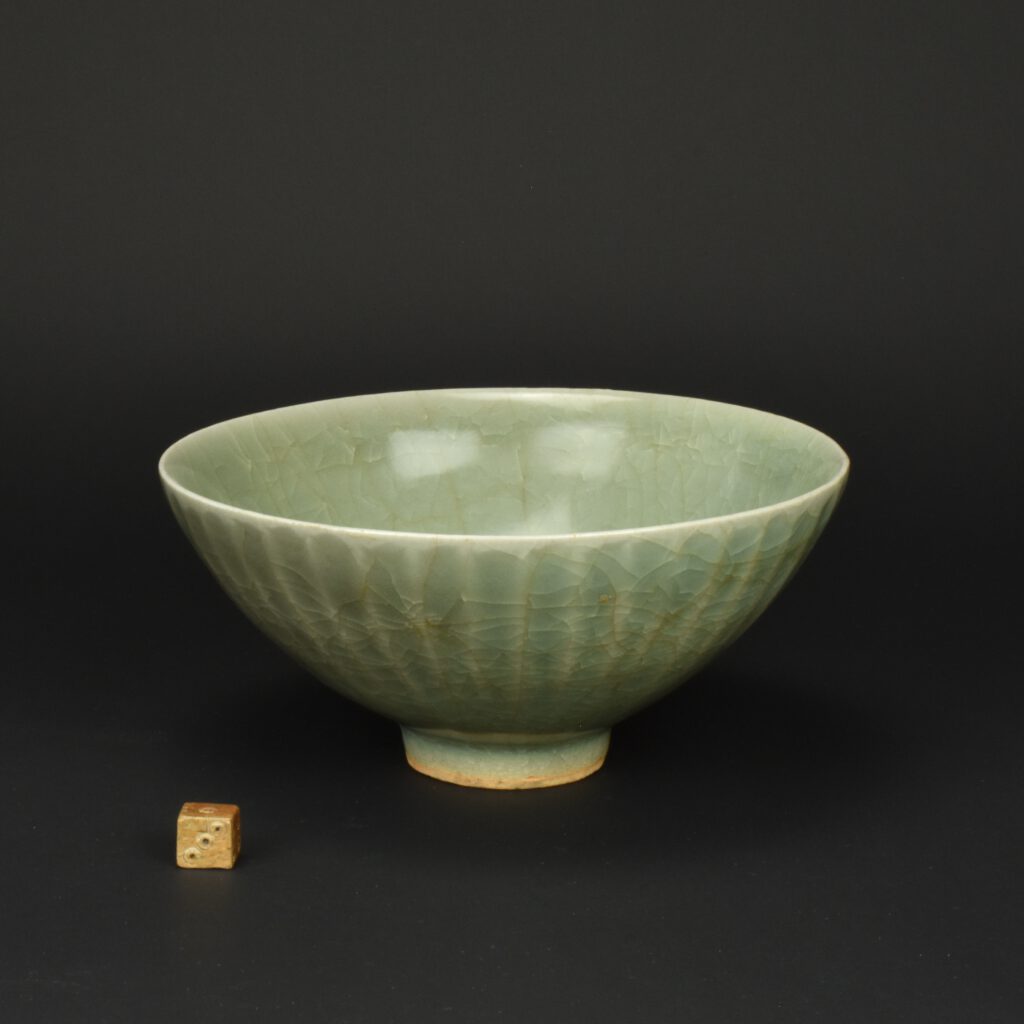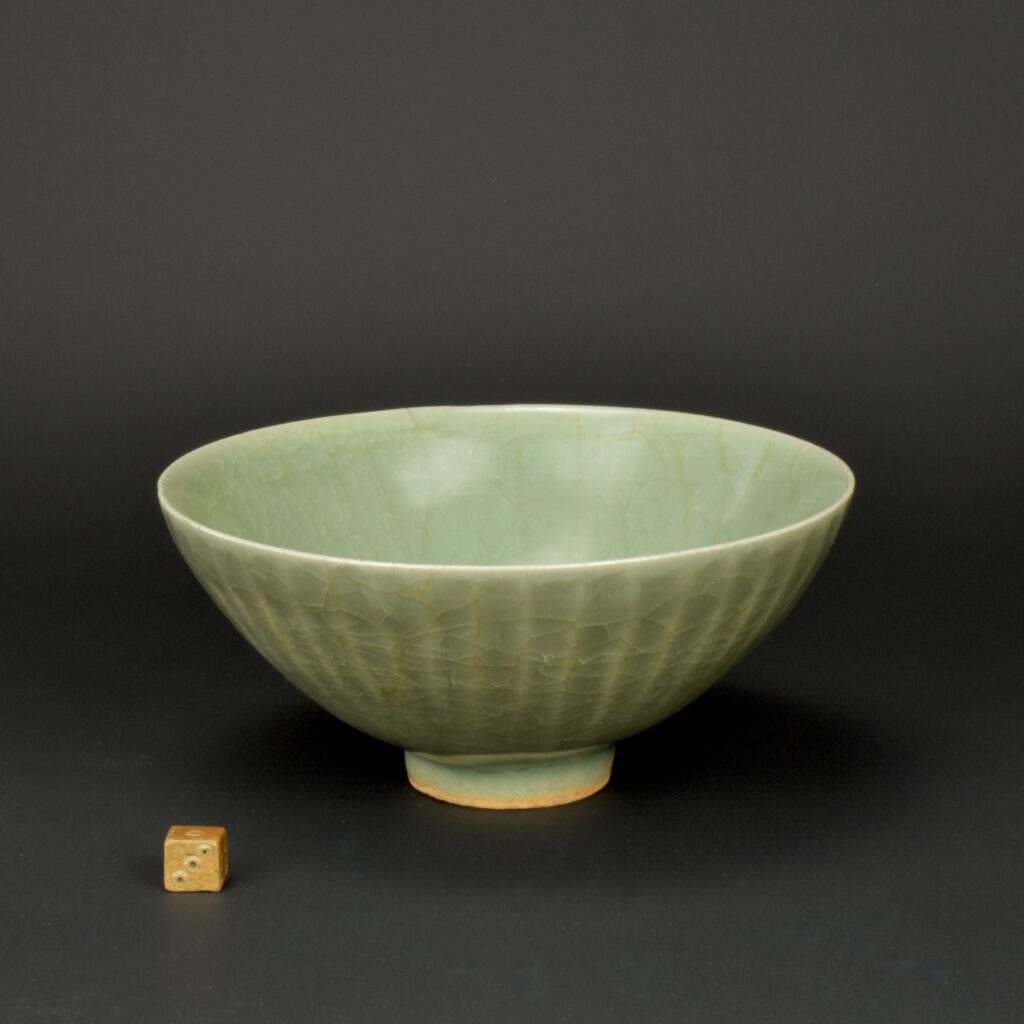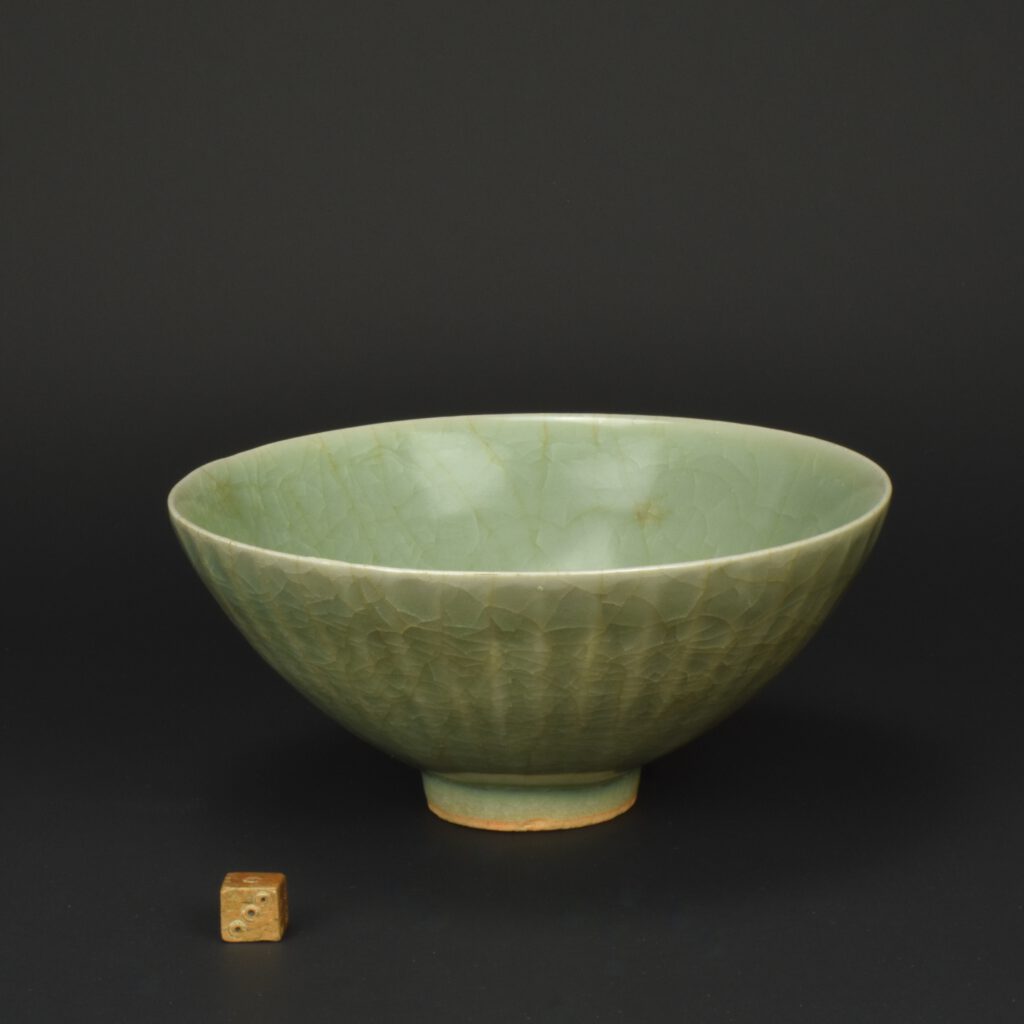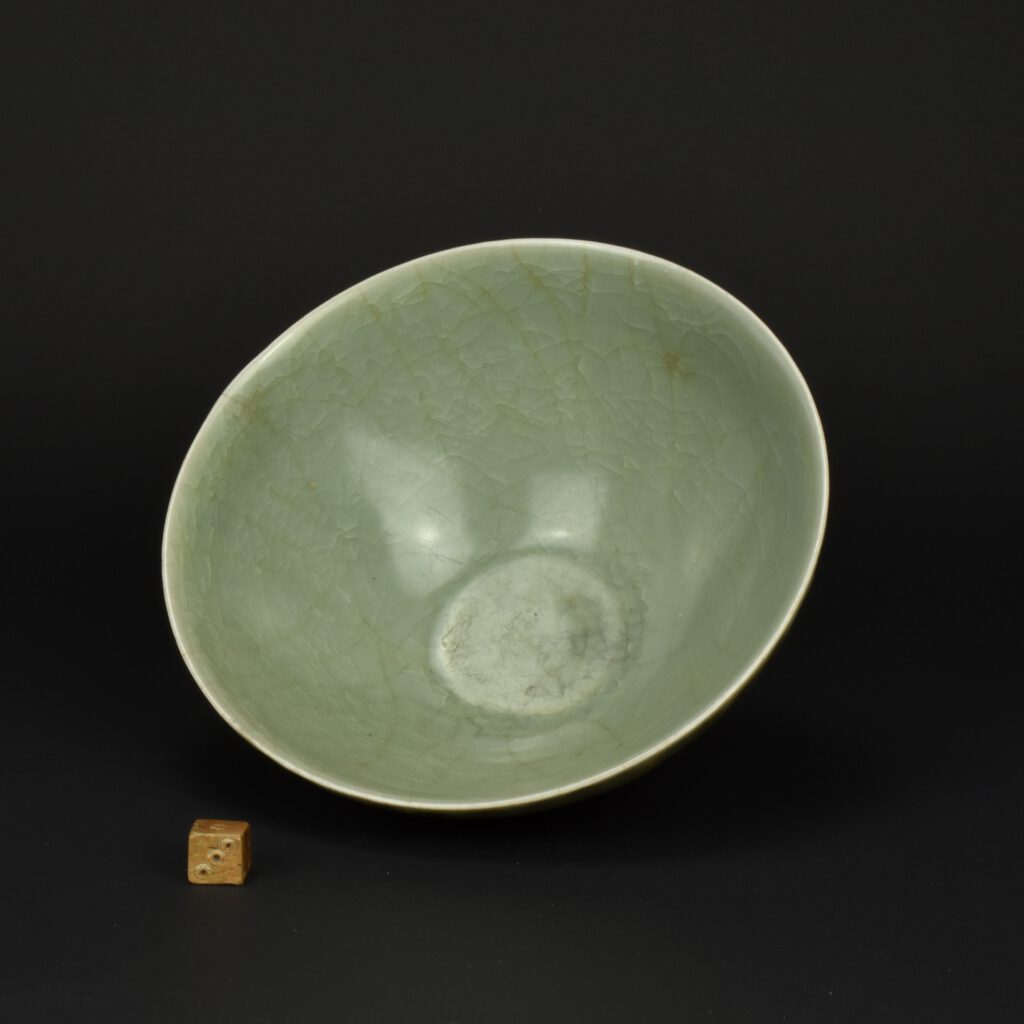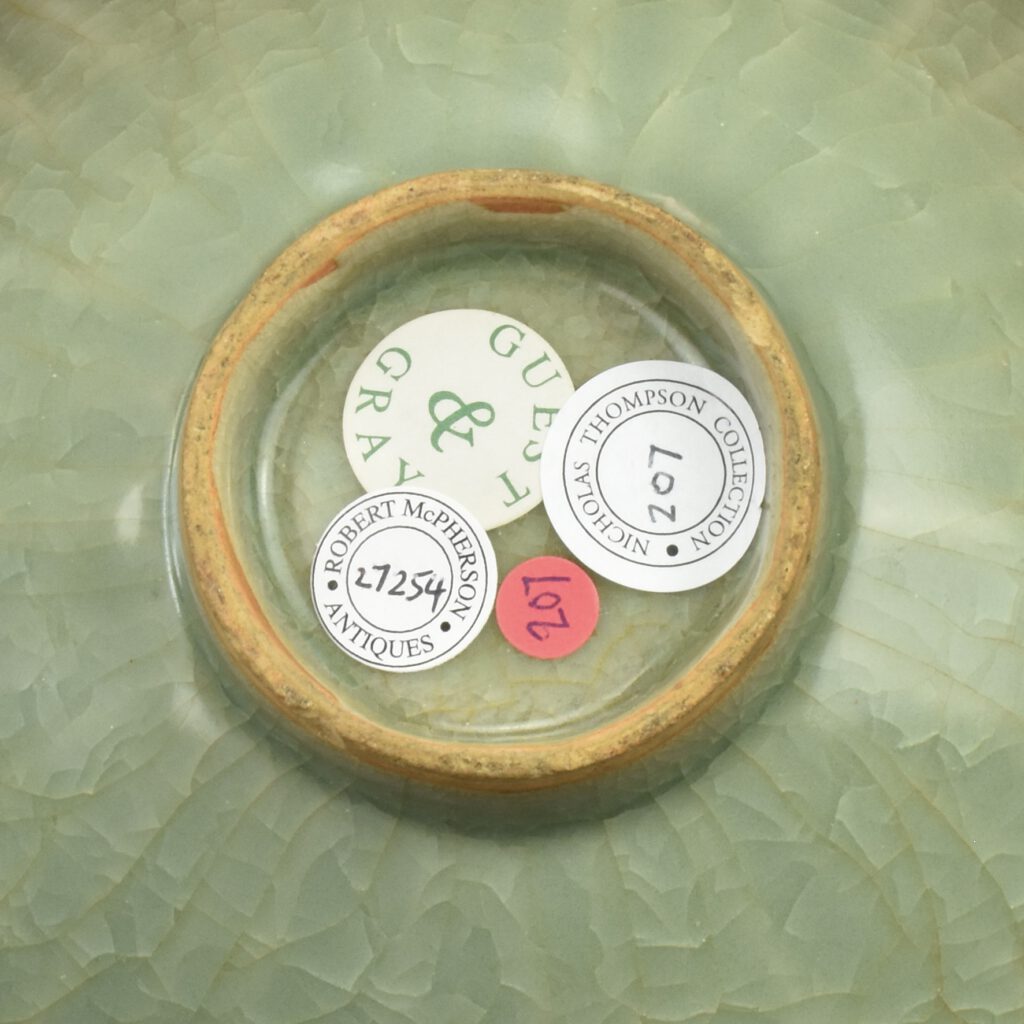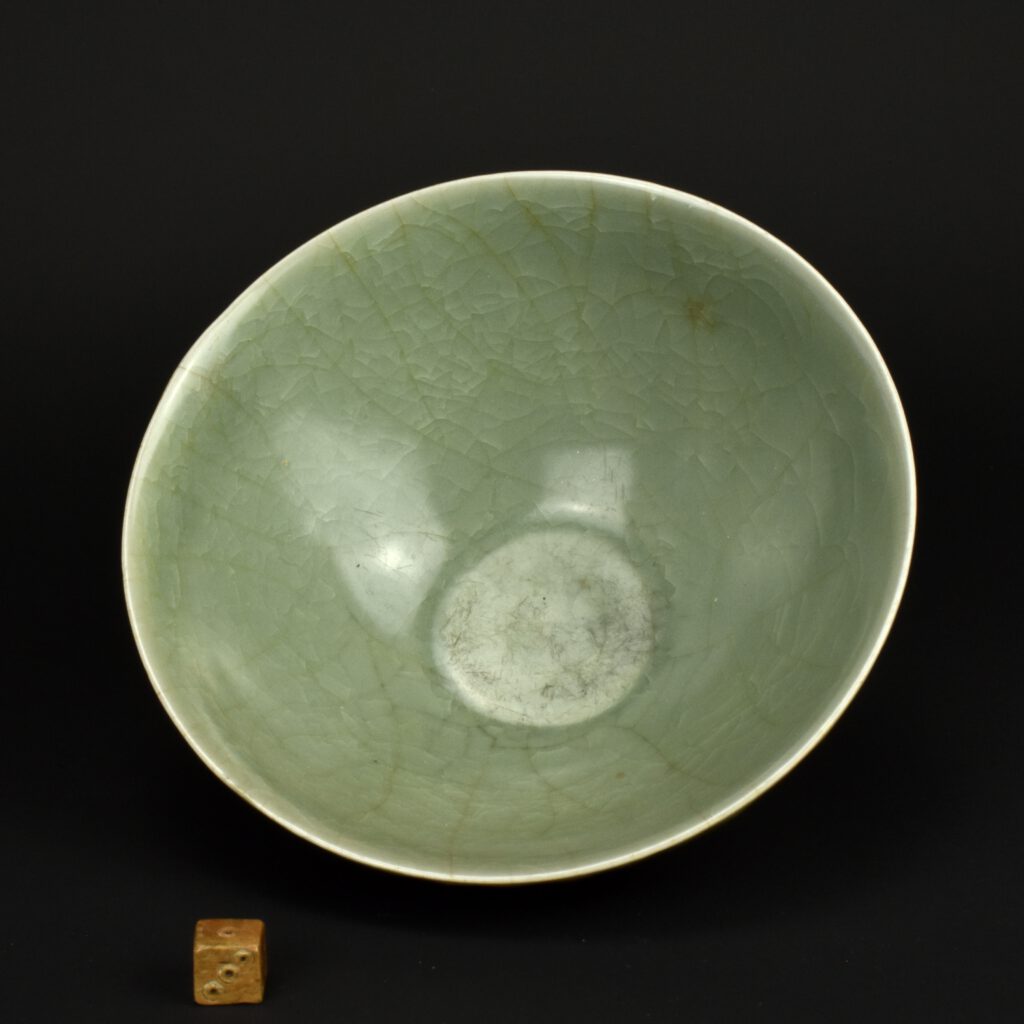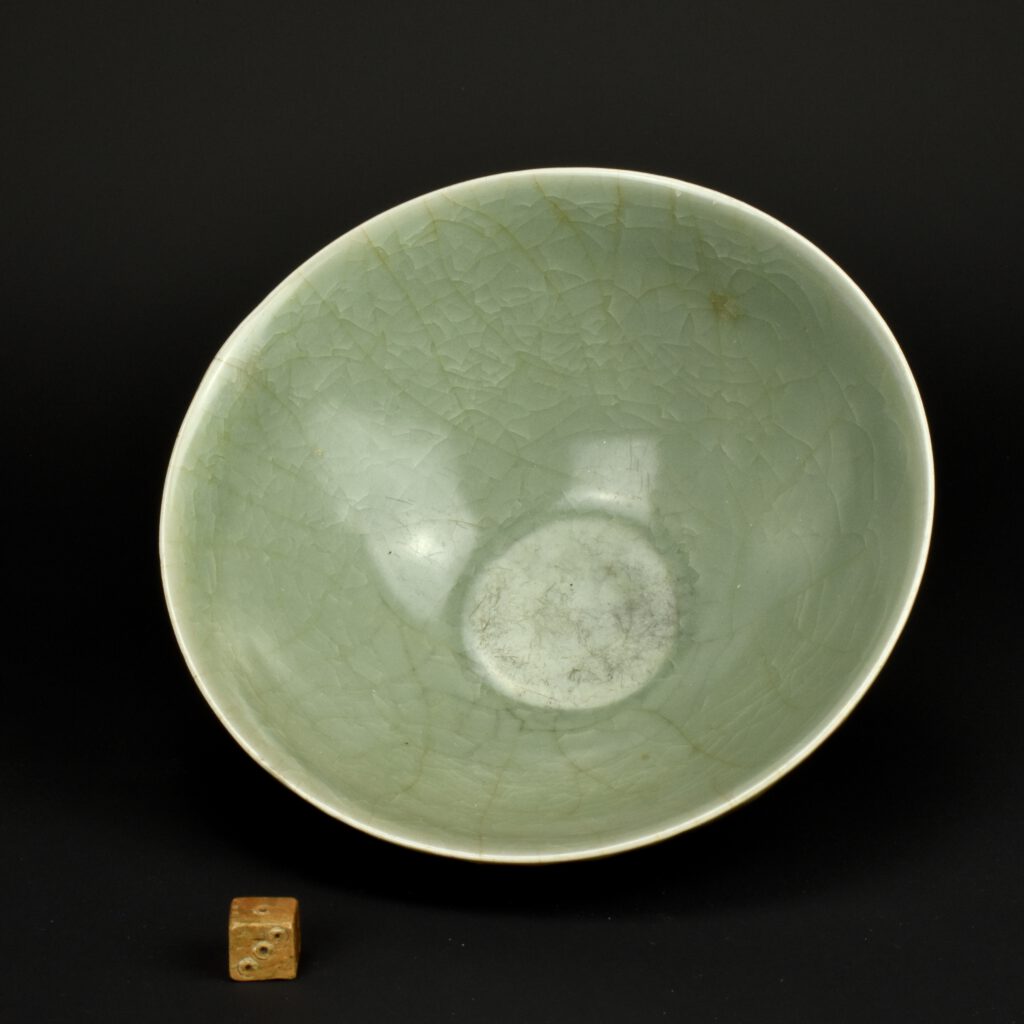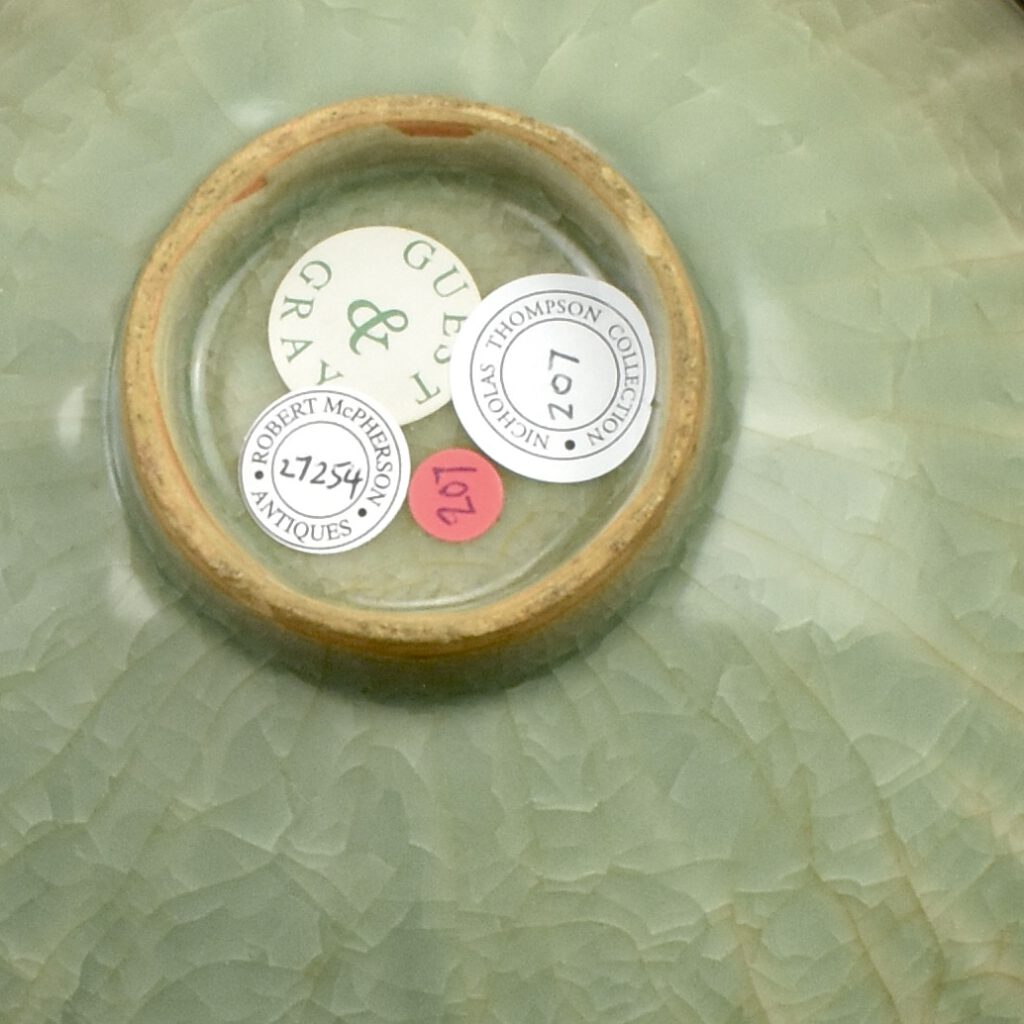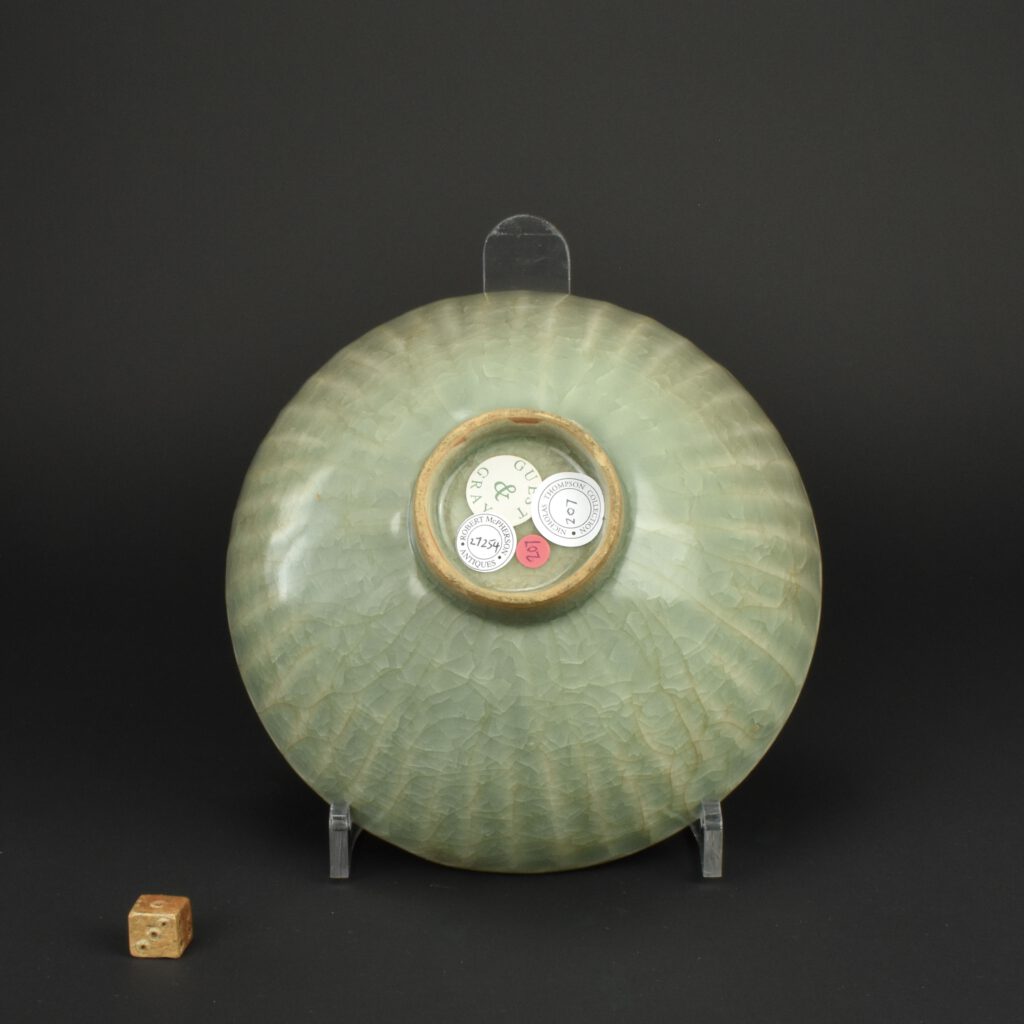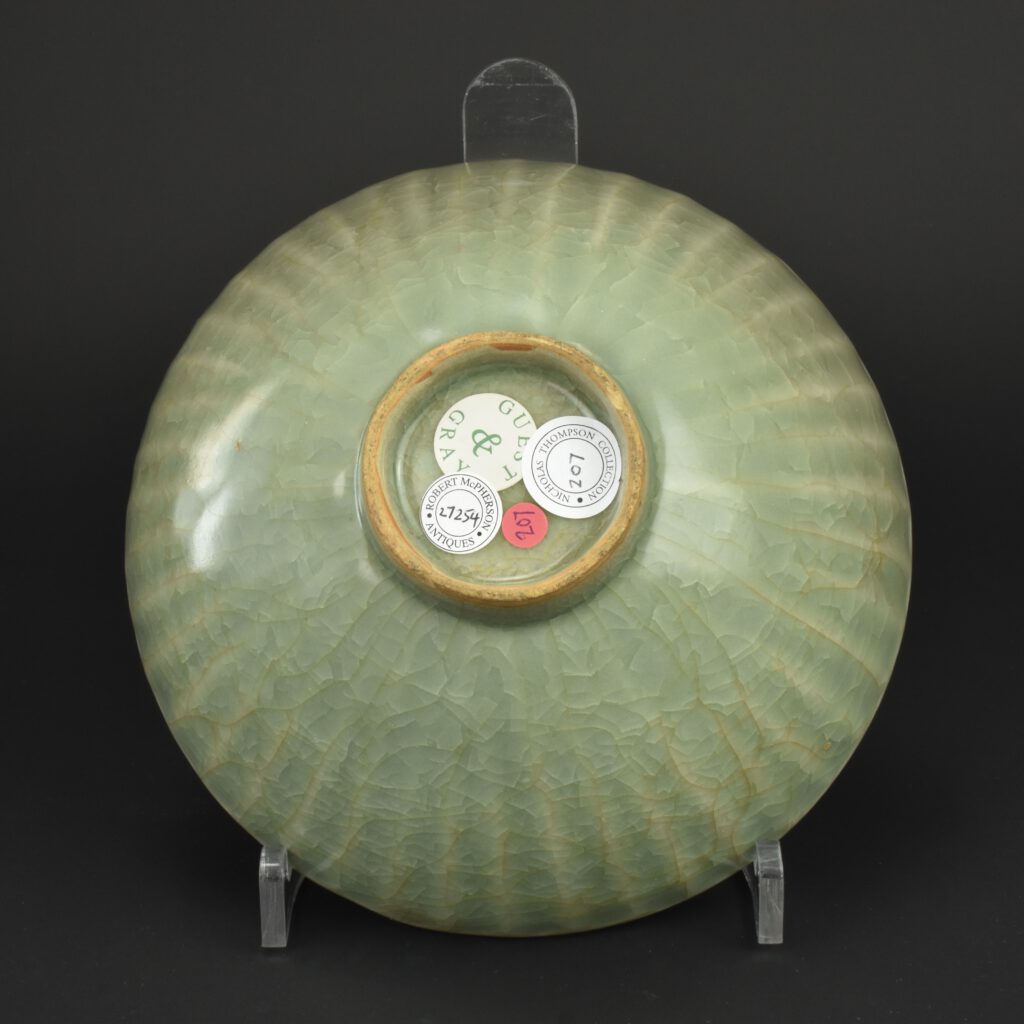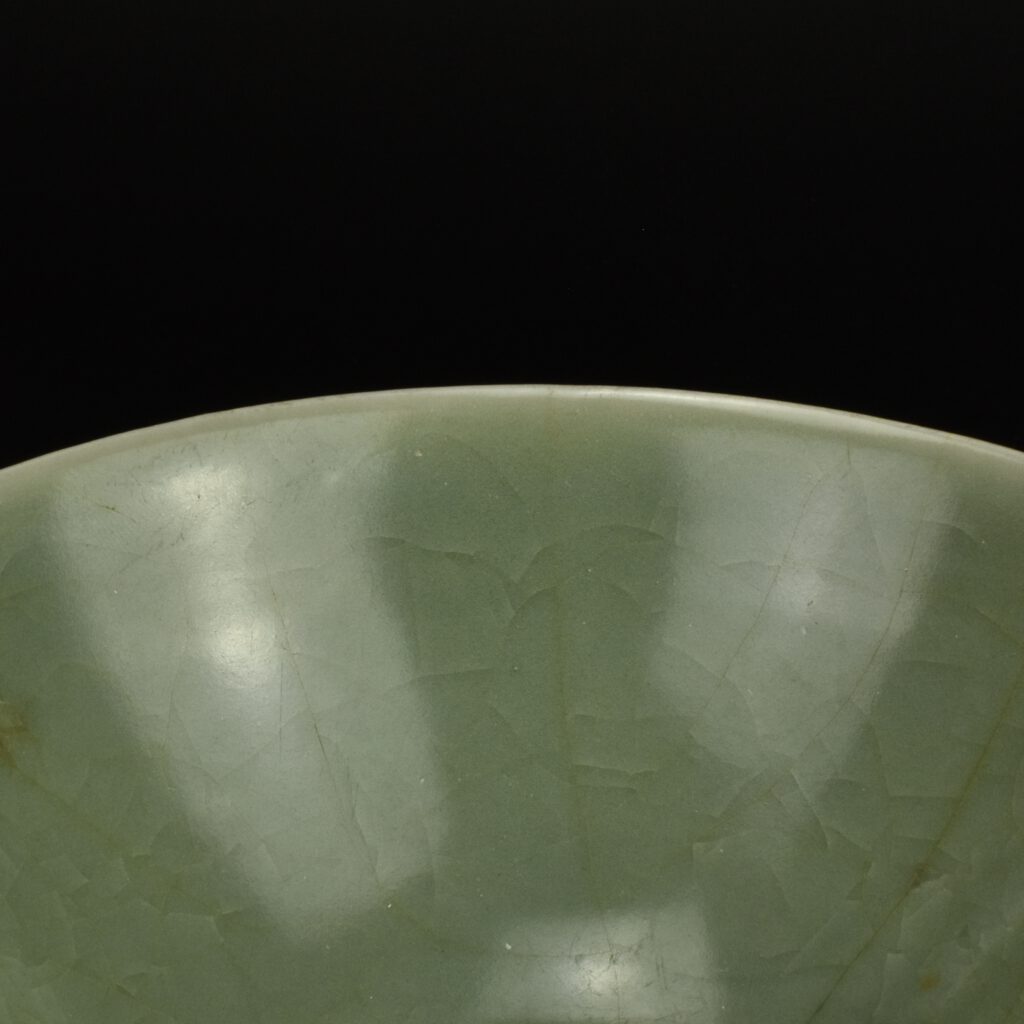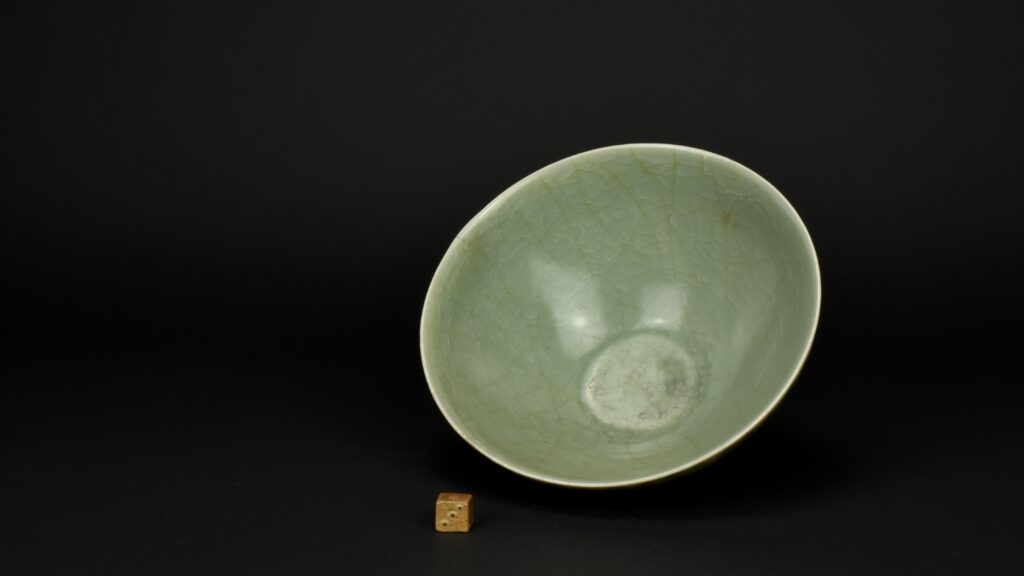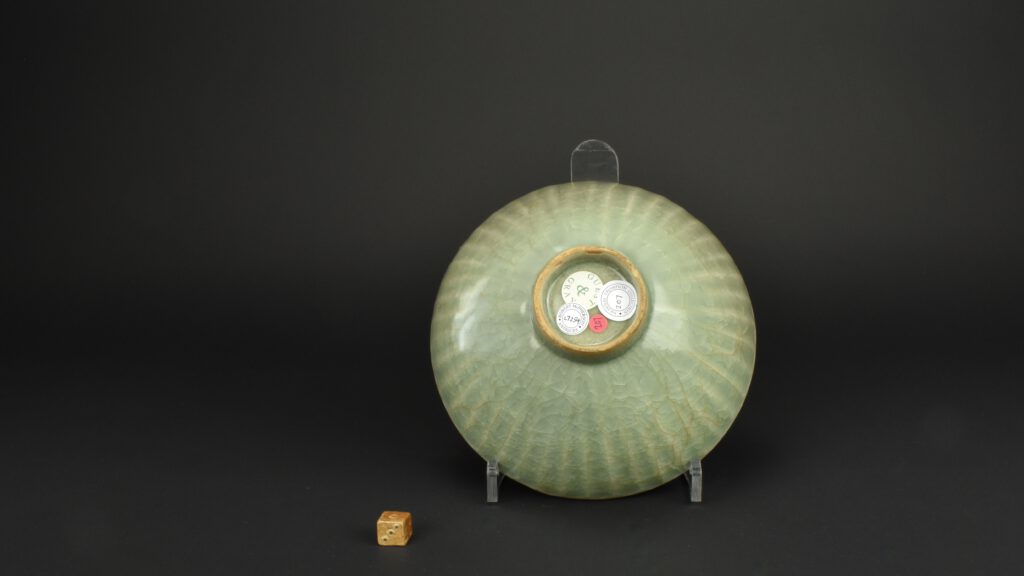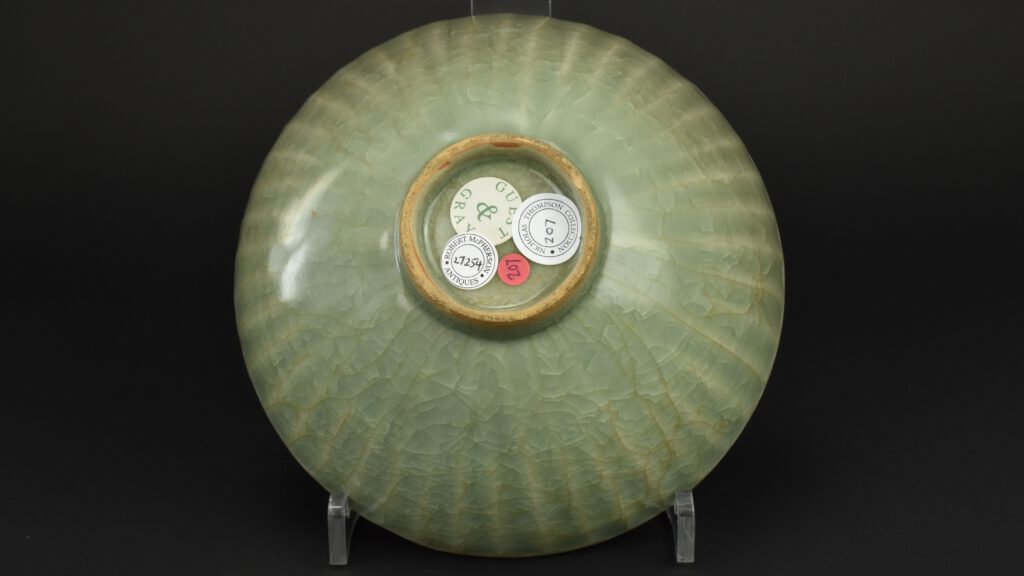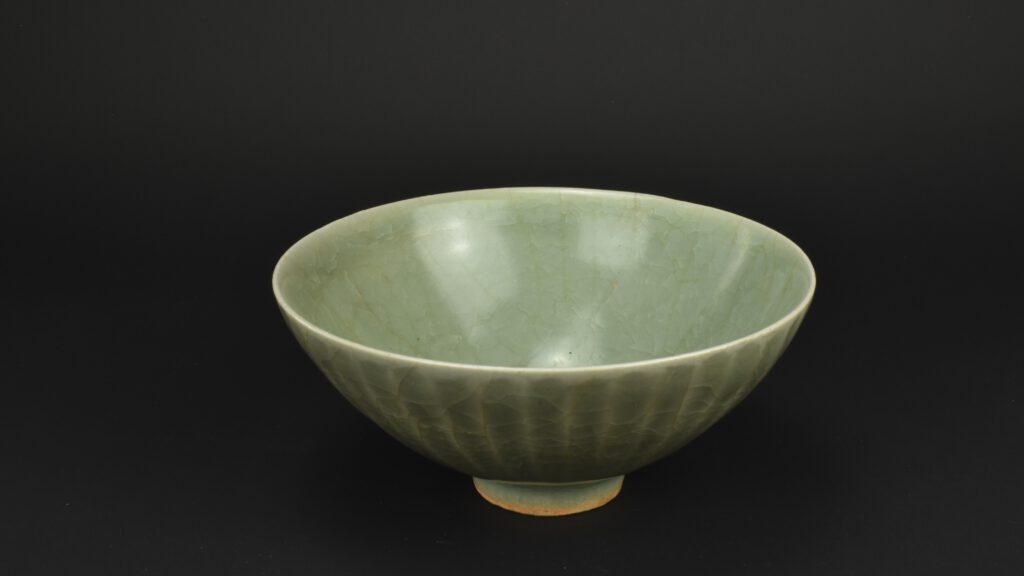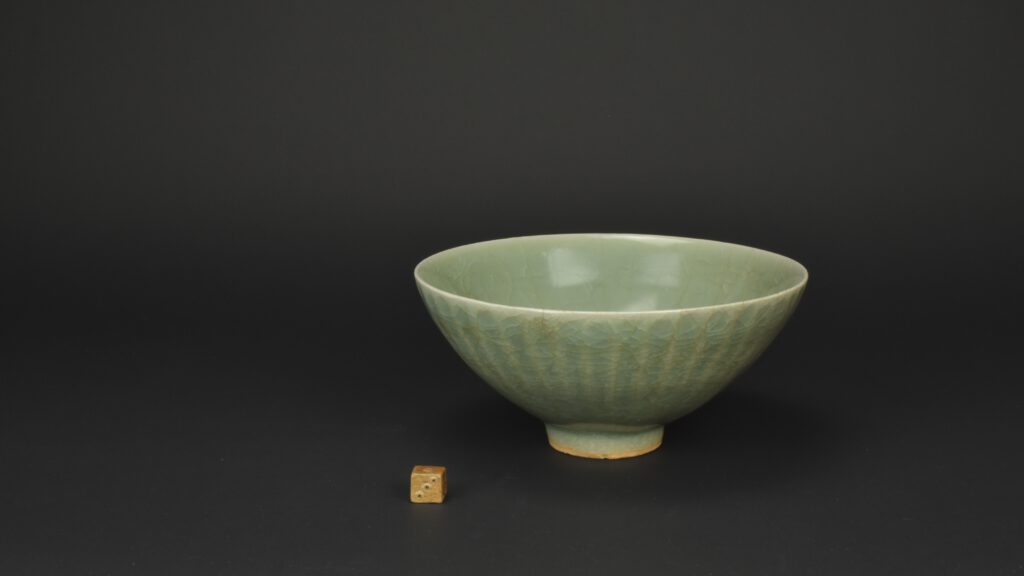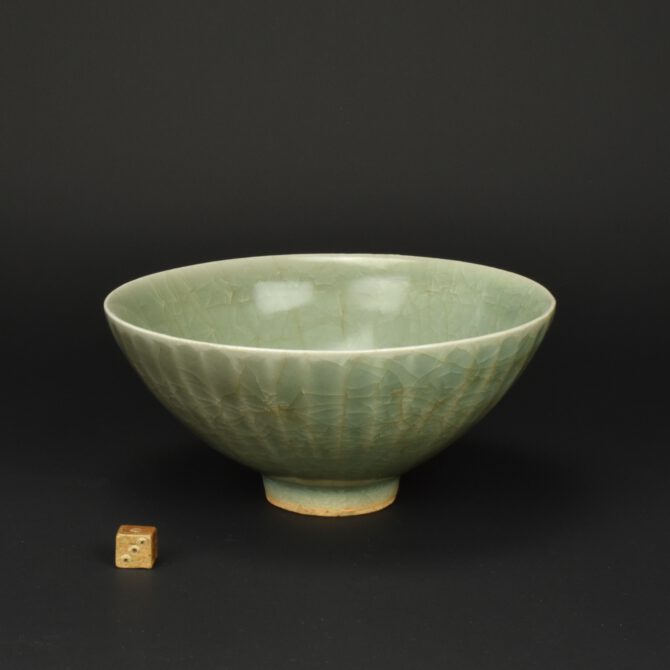
A Yuan Dynasty Longquan Celadon Lotus Bowl
A Yuan Dynasty (1279-1368), Longquan Kilns. A Celadon lotus bowl. From the collection of Nicholas de la Mare Thompson. This rather elegant bowl has a very attractive sage green coloured thick translucent crazed glaze. The exterior is moulded with upright lotus petals which are visible beneath the glaze. The high foot is neatly pottered, chamfered to interior, the biscuit porcelain has a thin orange line where it meets the glaze, this was caused by iron oxides migrating to the surface during the glaze firing (finial firing). Bowls of this type were recovered were recovered from the Sinan Wreck of 1323 and illustrated a catalogue ; Special Exhibition of Cultural Relics Found off Sinan Coast, National Museum of Korea 1977 (see References). As well as being exported, these bowls were very popular in China. Over five hundred of these celadon bowls were discovered in a Yuan tomb in Dongxi, Jianyang county, Sichuan province. Others were found in Yuan dynasty hoard of Longquan celadon ware in Taojiang county, Hunan province ; Meiyintang Collection, Volume One, see References. Two bowls of this type from the Mrs Alfred Clark were sold by Sotheby & Co, Bond Street in 1975, see References.
See Below For More Photographs and Information
SOLD
- Condition
- In very good condition, crazed glaze, minute chips to the foot rim.
- Size
- Diameter 16.5 cm (6.5 inches). Height 7.5 cm (2.9 inches)
- Provenance
- Guest and Gray, London, 13th of September 2004. From the Nicholas de la Mare Thompson (1928-2010) collection of Early Chinese Ceramics.
- Stock number
- 27254
- References
- Bowls of this type were recovered were recovered from the Sinan Wreck of 1323. See : Special Exhibition of Cultural Relics Found off Sinan Coast, National Museum of Korea 1977, Samhwa Publishing Co, Seoul, Korea, plate 15. Sinan Wreck of 1323 was large merchant vessel pulled up anchor at Qingyuan Port (now Ningbo City) in Zhejiang Province of the Yuan Dynasty (1271-1368) and left on a voyage to the Port of Hakata (now Fukuoka) in Japan in 1323. The trade ship, estimated to be 34 meters long and 11 meters wide, was loaded with Chinese ceramics, wooden lacquerware and metal crafts, but it never reached its destination -- it foundered off the southwest coast of Sinan, South Jeolla Province. Over five hundred of these celadon bowls were discovered in a Yuan tomb in Dongxi, Jianyang county, Sichuan province. Others were found in Yuan dynasty hoard of Longquan celadon ware in Taojiang county, Hunan province see : Meiyintang Collection, Volume One (Regina Krahl, Azimuth Editions 1994. ISBN 1-8985592-02-0) page 290, plates 539 to 544. Two Longquan celadon bowls of this type from the Mrs Alfred Clark were sold by Sotheby & Co, Catalogue of Important Chinese Ceramics, Property of Mrs Alfred Clark, tuesday 25th of March at eleven o'clock precisely, page 67, lot 56 sold for £400 and 57 £600.
Information
Celadon Ware
Celadon is a term used to describe several types of Chinese stoneware and porcelain, as well a ceramics from other countries, notably from Korea and Japan. The term is a imprecise one, applying to various types of green glazed ceramics, but not all ceramics with green glazes, there are several wares that have a green glaze that are not refereed to as celadon. For example Green Jun and Ge Ware. For this reason there has been a move to try to clarify the situation by using the term `Green Ware`. But for now Celadon is a more familiar and therefore useful term. The origins of the term Celadon are not clear, one theory is that the term first appeared in France in the 17th century and that it is named after the shepherd Celadon in Honoré d`Urfé`s French pastoral romance, L`Astrée (1627), who wore pale green ribbons. (D`Urfe, in turn, borrowed his character from Ovid`s Metamorphoses.) Another theory is that the term is a corruption of the name of Saladin, the Ayyubid Sultan, who in 1171 sent forty pieces of the ceramic to Nur ad-Din, Sultan of Syria. Yet a third theory is that the word derives from the Sanskrit sila and dhara, which mean "stone" and "green" respectively. Celadon ware originated in Zhejiang Province in the Eastern Han Dynasty, however green monochrome glazes can be found on stoneware much before that date. Zhejiang is were the famous Longquan Celadons were made but Celadon wares were also produced at Jiangsu, Hubei, Hunan and Jiangxi. The production of Celadon Ware required a reducing atmosphere of around 1300 degrees C., the colouring agent was a mixture of iron oxide and titanium. The glaze was applied very thickly, and was full of tiny bubbles which defuse the light giving the appearance of richness and softness.
Nicholas de la Mare Thompson (1928-2010).

Nicholas de la Mare Thompson, the grandson of the author Walter de la Mare spent his career in publishing. He started at Nesbit where he was editor of the Janet and John series of children’s books but not all of his career was so safe. He wrestled with W.H. Smith over the content of Madonna’s raunchy Sex book on behalf of Paul Hamlyn’s Octopus Group and defeated Margaret Thatcher over Spycatcher. He could not bare dogma or hypocrisy.
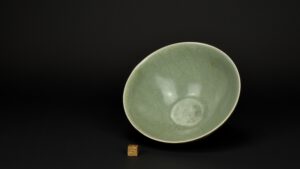
It was hardly surprising that as a committee member of the O.C.S. he had his own ideas. He read and could recite great swaths of the articles of the Society, he used this not to attack but to stimulate debate. He approached the Society in the same way as he approached his understanding of Chinese ceramics, by stripping it down and starting again using clear empirical thinking. He was very concerned the Society was open to all and was run for the benefit of all members.
Nicholas came from a family of collectors, his love of oriental ceramics was broad but his focus was on early monochromes, especially those from the Song dynasty. He bought what he loved, what he thought had merit, not what was said to be good, and certainly not anything because it was fashionable. He didn’t have a stamp collectors’ approach, filling in the gaps of pre-existing ordered collection, rather he would react to an object, feeling it was right for his collection. Sometimes he wasn’t sure if it was right for his collection or not. He would then “borrow” pieces and live with them, other times he would ask his wife Caroline, who’s eye he trusted, if he should keep the piece or not. He was amused because I was often able to know if he would keep a piece before he did. We discussed “pots” endlessly, he loved to talk about ceramics with a wide variety of people and enjoyed the company of others on O.C.S. trips as well as in discussion groups or anywhere else. Later on he combined his love of Chinese ceramics with his love of books by extending his library to include rare early books, he used these to trace the development of collecting and scholarship in the 19th and early 20th century. He was fascinated by earlier scholarship, what was not understood but also what they understood, and we have lost. He was always reading and wanted to know more right up to the end, he didn’t see impending death as a barrier to knowledge or indeed collecting. The week before he died he questioned, if only for a second, whether it was too late to buy another pot for the collection. He concluded it was not, he was a true collector.
Nicolas died on the 25th of April 2010 at the age of 82 after living with cancer for two years. He leaves behind his energetically supportive wife Caroline and his three children. He was a kind, gentle and incredibly civilised man with a very sharp mind and dry sense of humour, he was passionate about the Society, its aims and its members. He was an incredibly supportive and thoughtful friend and will be missed very much.
